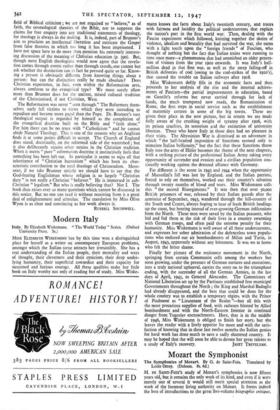Mozart the Symphonist
The Symphonies of Mozart. By G. de Saint-Foix. Translated by Leslie Orrey. (Dobson. 8s. 6d.)
M. DE SAINT-Fones study of Mozart's symphonies is now fifteen years old, but it remains the only work of its kind, and even if it were merely one of several it would still merit special attention as the work of the foremost living authority on Mozart. It forms indeed the best of introductions to the great five-volume biographic critique, a complete translation of which, it is good to hear, is also in pre- paration. Mark Pattison was once asked by a pupil to recommend a suitable subject for research. He suggested an edition of Selden's Table Talk, and proceeded to tell his enquirer how he should set about it. He must, he said, first get the contents of the book prac- tically by heart, and then read the whole literature of Selden's day and of the generation before him; only then, after some twenty years, would he be fully equipped for his task. M. de Saint-Foix is a scholar of the true Pattisonian stamp. He has not only studied everything that Mozart himself wrote (in itself no mean feat) but has made himself familiar with the compositions of most of his pre- decessors and contemporaries. He has thus been able not only to detect the many subtle variations of style that characterised Mozart's development as a composer, but also to idefrify in many cases the very models from which he drew his inspiration.
His full achievement can only be studied in the famous five volumes, where the composer's progress can be followed step by step and every generalisation is supported by a wealth of evidence. In the smaller book much has to be taken for granted and there are inevitable gaps. Nevertheless the long line of " symphonies " is continuous enough to exhibit almost every aspect of Mozart's genius, especially as Saint-Foix interprets the term symphony generously, to include the concertanti, the orchestral serenades, the Musical ;Poke and the Masonic Funeral Music. He is specially stimulating on the early works, where his wide knowledge enables him to show just what Mozart owed to his models and what he contributed himself. He rates some of them very highly indeed, and though the sceptical may suspect him of exaggeration, examination of the scores shows that his praise is almost always justified. On the acknowledged masterpieces Saint-Foix has naturally not so .much that is fresh to say. To the final three symphonies he devotes no less than 70 pages. He believes them to have been designed as a trilogy, though not necessarily intended for consecutive performance.
" In bestowing the title ' trilogy' on this famous set of masterpieces the suggestion of a bond between them is intentional ; this trinity, we may be sure, has not come about by chance. Never since he arrived at maturity had [Mozart] produced, at intervals of a few days only, a succession of compositions of the same calibre ; the E flat symphony represents an immense portico through which the com- poser reveals to us all the warm and poetic beauty thronging his mind, before surrendering "himself before our eyes to a struggle of exalted passion to be manifest in the' symphony in G minor ; and finally he invites our presence at a sort of apotheosis of his musical genius, freed from all shackles, in what has come to be known as the ' Jupiter ' symphony. This imposing triple aspect that he gives to his symphonic testament in some measure sums up for us his inmost soul, and one can well understand that the pro- duction of the first should be followed so closely by the other two."
Conjecture can move freely here, for, oddly enough, we know nothing of the circumstances in which these great works were written.
In default of contemporary comment Saint-Foix quotes some in- structive passages from critics who heard them when they were first performed in Paris at the beginning of the nineteenth century.
Some of these strike a very modern note ; indeed nearly a century was
to pass before writers were again to discover the " demonic " element in Mozart that was so evident to these early hearers. A generation later the Romantics, who were nothing if not demonic themselves, were to create the legend of the serene Olympian, remote from the troubles and emotions of ordinary mortals. It is not the least of Saint-Foix's services qo have, demolished this legend and to have shown, in loving detail, the full range of Mozart's achievement.
The translation is adequate but by no means faultless, and there are some tiresome misprints. In other respects the English edition is a great improvement on the French original : the numerous musical illustrations are at last decently printed, there are some attractive illustrations, and the translator has added a few supplementary notes,
a table of works discussed and an index. C. B. OLDMAN.



































 Previous page
Previous page